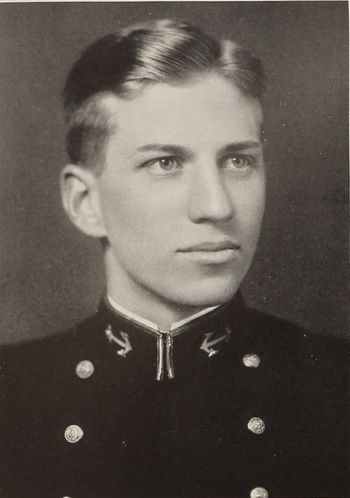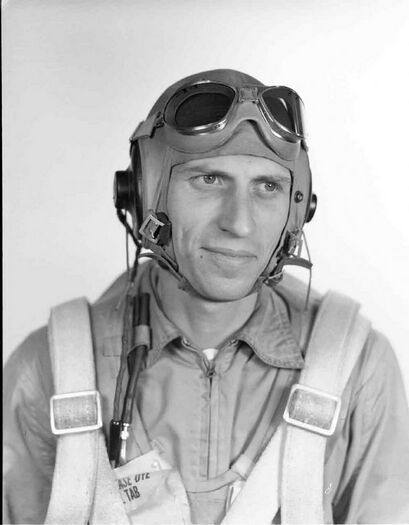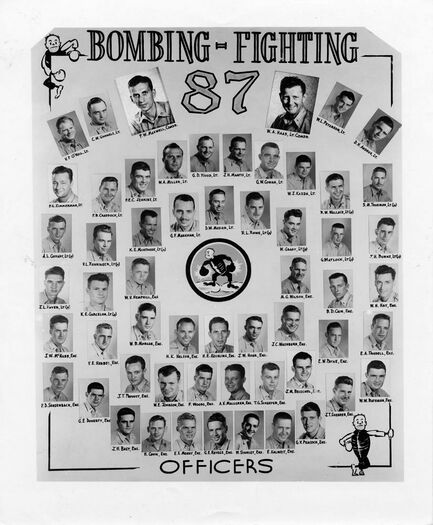PORTER W. MAXWELL, CDR, USN
Porter Maxwell '36
Lucky Bag
From the 1936 Lucky Bag:
Porter Wilson Maxwell
Charleston, West Virginia
"Maxie"
MAXIE, heeding the adventurous call of the sea, laid aside the jug of cawn, bid the folks and winsome mountain lassies goodbye, and hit the trail for Annapolis. His carefree attitude and utter disregard for the many difficulties which marked this new career soon won him an unlimited host of friends. Naturally energetic, Porter turned to athletics; participating in basketball and lacrosse with more than average success. Maxie's pet avocation is the expounding of his philosophical views on love and life, and we will all agree that he ranks among the best of the sea lawyers. Independent and ambitious; these are the characteristics which predict a bright future for Maxie. Once course and speed are set, life will be smooth sailing for the seagoing mountaineer.
Football 4; Basketball 4, 3, 2, 1. N.A.; Lacrosse 4, 3, 2, 1. N; N Club; Expert Rifleman; Two Stripes

Porter Wilson Maxwell
Charleston, West Virginia
"Maxie"
MAXIE, heeding the adventurous call of the sea, laid aside the jug of cawn, bid the folks and winsome mountain lassies goodbye, and hit the trail for Annapolis. His carefree attitude and utter disregard for the many difficulties which marked this new career soon won him an unlimited host of friends. Naturally energetic, Porter turned to athletics; participating in basketball and lacrosse with more than average success. Maxie's pet avocation is the expounding of his philosophical views on love and life, and we will all agree that he ranks among the best of the sea lawyers. Independent and ambitious; these are the characteristics which predict a bright future for Maxie. Once course and speed are set, life will be smooth sailing for the seagoing mountaineer.
Football 4; Basketball 4, 3, 2, 1. N.A.; Lacrosse 4, 3, 2, 1. N; N Club; Expert Rifleman; Two Stripes
Loss
Porter was lost when his F6F-5 Hellcat was shot down near Kure, Japan, on July 24, 1945. He was commanding officer of Bombing Fighting Squadron (VBF) 87 and was operating from USS Ticonderoga (CV 14); he had taken command on January 2, 1945.
Other Information
From the Class of 1936's "Golden Lucky Bag," published in 1986 (via Marianne Bradley, daughter of LCDR John Ellis '36, USN (Ret.)):
After graduation, Porter served in the battleships Tennessee and New York and the destroyer Kane. Going to flight training in August 1940, he completed the course the following March and was assigned to Scouting Squadron 71 (VS-71) in Wasp.
After Wasp was sunk on 15 September 1942 by an enemy submarine, VS-71 operated from Henderson Field, Guadalcanal, where Porter was listed as commander of a detachment from the squadron. Later, he was Commanding Officer of Bombing Squadron 97 and in the last weeks of the war, CO of VBF-87 on board Ticonderoga. On 24 July 1945, his carrier, as part of Task Force 38, was making strikes against targets on the Inland Sea and Nagoya. Leading his squadron in the attacks, Porter's plane was hit and he failed to return to the carrier. Just two weeks later, B-29s dropped their A-bombs on Japan, effectively ending the war.
A report from an anonymous officer in Porter's squadron gives some details on his death. On the day on which he was lost, Porter led the first 16 plane strikes hitting airfields in Northwestern Shikoku and shipping in the Inland Sea, causing much damage despite a 2,000-foot ceiling that prevented high-angle dives. Porter's plane was at only 150 feet when it was hit by intense antiaircraft fire from Nihama Airfield and plunged into the water adjacent to the field. Porter's parachute was already streaming as he ejected but no survivor was seen near the crash.
For his wartime service, Porter was awarded the Silver Star, the Distinguished Flying Cross, the Air Medal, the Purple Heart, and the Presidential Unit Citation. It was the fortunes of war that he did not live to see the victory that was so close and for which he had fought so long and so hard. Porter was survived by his widow, the former Helen Forsyth of Evanston, Illinois, and a daughter, Bonnie.
OF PORTER MAXWELL AND A PLANE RIDE
By Joe Barker
The 7th SeaBees had gone ashore at Espiritu Santo on 11 August 1942 — we had been scheduled for Guadalcanal, but the cruiser debacle a couple of nights earlier had made diversion necessary.
Our first priority was to hack some air strips out of the coconut groves and jungle, and we did pretty well in spite of pitiful equipment - only a couple of small bull dozers at first, half a dozen small Chevy trucks, etc., and this manhandled ashore using ship's boats and old French wooden barges.
Anyhow, we got a fighter strip operational in a very short time, and a bomber strip soon thereafter. I can remember one of the first B-17s coming in with a side gunner slumped dead over his gun at the open starboard side port.
One day in September 1942, I was out at the strip when a group of strange carrier planes circled and landed. I went over to investigate, and recognized Porter Maxwell climbing out of an SBD. Seems they had been out on a strike and returned to find the Wasp burning. Fortunately, they still had enough fuel to reach our new coral sanctuary.
I gave Porter my spare shirt and squeezed a cot into my tent. But a Jap submarine shelled us that night, which irritated Porter, and he vowed to go hunting the next day. Since his regular rear gunner wasn't around, he asked me if I'd like to go along.
I'd last flown Navy in an SOC off the old New Mexico, so this ride was something new, as well as a bit irregular. Porter didn't take time to check me out on the hardware, so I wasn't at all sure what to do it we actually found a Jap submarine!
We scouted around for an hour and then Porter thought he saw something, so over we went. Down, down, down, with a pullout behind one of the outer islands. False alarm; Porter had had enough, so we returned to base, low over the water.
The whole place was in an uproar. Our plane had been seen to go down behind the outer island, and the whole search apparatus was out looking for us. Porter caught hell for "joyriding"; like an innocent Seabee, I disappeared into the jungle.
The Wasp planes left in a couple of days. I never saw Porter again.
From the an article on James Vernon, a pilot in Porter's squadron, in the Ventura County Star on August 6, 2008:
Much of the flying that Vernon's group did involved trying to find the bases where kamikaze aircraft were hiding and put them out of commission before they attacked the American fleet.
"Kamikazes killed about 10,000 American sailors," he said. "We tried to find them before they found us."
During one such mission, Vernon was wingman to the squadron leader, Cmdr. Porter Maxwell. They were not facing fighter plane opposition, but there was a great deal of antiaircraft fire from the Kure Naval Base, he said.
Flying south and then east of Hiroshima over Niihama Bay, Vernon said, "the skipper was on my left and all of a sudden, I noticed what looked like debris coming from his tail. It just seemed to fall apart."
Vernon recounts what happened next in his book, "The Hostile Sky":
"The skipper's canopy opened, he stood up, his parachute streamed out and jerked him clear of the plane. The Hellcat hit the water with the skipper a few feet to the right of it.
His parachute didn't blossom to check his fall; he plunged feet first into the murky shallow water and disappeared."
His wife was listed as next of kin. Porter is buried and has a separate memory marker in West Virginia.
Photographs
Remembrances
From The Hostile Sky: A Hellcat Flyer in World War II By James Vernon:
The commanding officer, Commander Porter W. Maxwell, USN, U.S. Naval Academy Class of 1936, was among the last officers to report. He had a reputation as a no-nonsense, stern, and aloof man. That was an understatement. He carried his slender, well-proportioned, six-foot-three-inch frame gracefully. His narrow, spare face with a full mouth, slender nose, and narrow chin made a striking impression, like the Indian warrior chiefs Sitting Bull and Crazy Horse. His eyes, large and bulging, were most impressive. When he first fixed them them on me with one of his intense stares, I knew how a webbed fly must feel as the spider approaches. They were a challenge to see if you would stare back. No one did. A least I didn't. I had the feeling he made a penetrating visual evaluation and established dominance much like male dogs do when, with legs stiff, tail high, and a fixed stare, they circle a stranger. I knew I would take no liberties with him. "He's got gun-muzzle eyes and a rifle barrel up his ass," Dick said. "They're standard issue at the naval academy, you know." After a few weeks, he seemed to relax a little, but I saw no indication that he formed friendships with anyone. He suffered from the loneliness-of-the-leader syndrome.
Together, Maxwell, the skipper, and Haas, the executive officer, had the needed experience to train this new type of squadron. Maxwell had combat experience in the Solomon Islands flying dive-bombers and had headed a dive-bomber training program in Florida before he had become commanding officer of VB-87 at Wildwood. …
VBF-87 was among the first bombing-fighting squadrons in the Navy. With that distinction came the problem of determining to what extent the Hellcat fighter could play the role of dive-bomber.
The portion of the book that details Porter's loss is not included in the google preview, but the following is:
Writing such letters was a painful experience for the commander. The widow would have received through official channels a telegram: "We regret to inform you that your husband . . ." with no specifics. The details in the commander's letter would be a second shock to the wife and family, and a delayed sorrow for his newborn when old enough to grasp the truth. I envisioned photographs of the skipper hung in some honored niche in their shattered household, a superficial image of a deep, talented, and brave man. I also thought of the quirkiness of fate, that the bullets that downed him had missed me, flying only yards away from him.
The unofficial comments among the pilots had a different tone from the official debriefings. I wondered why the skipper had fired his rockets at the tanker at such long range that they hit far off the target Several men could not understand why he led us at low altitude needlessly through a known heavy concentration of antiaircraft batteries in the Kure area and why he took no evasive actions when flak burst thick among us. Why did he deviate from the strike plan? He led us far from the planned route, making it doubtful that we would have enough fuel to return to the carrier. Why was he so slow to respond to the sighting of the two seaplanes? Why didn't he take evasive action after the strafing run at Niihama? There may have been reasonable answers to those questions, but they died with him. And who would have asked them had he lived? Not I.
Silver Star
From Hall of Valor:
SYNOPSIS: Commander Porter W. Maxwell, United States Navy, was awarded the Silver Star for conspicuous gallantry and intrepidity in connection with military operations against the enemy as Commanding Officer of Fighting Bombing Squadron EIGHTY-SEVEN (VFB-87), embarked in U.S.S. TICONDEROGA (CV-14), in action against the Japanese on 24 July 1945. His gallant actions and dedicated devotion to duty, without regard for his own life, were in keeping with the highest traditions of military service and reflect great credit upon himself and the United States Naval Service.
General Orders: Bureau of Naval Personnel Information Bulletin No. 348 (March 1946)
Action Date: July 24, 1945
Service: Navy
Battalion: Fighting Bombing Squadron 87 (VFB-87)
Division: U.S.S. Ticonderoga (CV-14)
Distinguished Flying Cross
From Hall of Valor:
The President of the United States of America takes pleasure in presenting the Distinguished Flying Cross to Commander [then Lieutenant] Porter W. Maxwell, United States Navy, for extraordinary achievement while participating in aerial flight while piloting a dive bomber in the Solomon Islands area from 3 October to 8 November 1942. Commander Maxwell fought with outstanding skill and released his bombs on enemy surface forces, ground installations and troop concentrations. On 8 October he led his flight in an attack on the Japanese fleet near Guadalcanal and scored direct hits on a heavy cruiser.
General Orders: Bureau of Naval Personnel Information Bulletin No. 333 (December 1944)
Action Date: October 3 - November 8, 1942
Service: Navy
Rank: Commander
Distinguished Flying Cross
From Hall of Valor:
The President of the United States of America takes pleasure in presenting the Distinguished Flying Cross to Commander [then Lieutenant] Porter W. Maxwell, United States Navy, for extraordinary achievement while participating in aerial flight while piloting a dive bomber in the Solomon Islands area from 3 October to 8 November 1942. Commander Maxwell fought with outstanding skill and released his bombs on enemy surface forces, ground installations and troop concentrations. On 8 October he led his flight in an attack on the Japanese fleet near Guadalcanal and scored direct hits on a heavy cruiser.
General Orders: Bureau of Naval Personnel Information Bulletin No. 333 (December 1944)
Action Date: October 3 - November 8, 1942
Service: Navy
Rank: Commander
Related Articles
As an Ensign, Porter was in the wedding of his classmate Jack Crutchfield '36.
The "Register of Commissioned and Warrant Officers of the United States Navy and Marine Corps" was published annually from 1815 through at least the 1970s; it provided rank, command or station, and occasionally billet until the beginning of World War II when command/station was no longer included. Scanned copies were reviewed and data entered from the mid-1840s through 1922, when more-frequent Navy Directories were available.
The Navy Directory was a publication that provided information on the command, billet, and rank of every active and retired naval officer. Single editions have been found online from January 1915 and March 1918, and then from three to six editions per year from 1923 through 1940; the final edition is from April 1941.
The entries in both series of documents are sometimes cryptic and confusing. They are often inconsistent, even within an edition, with the name of commands; this is especially true for aviation squadrons in the 1920s and early 1930s.
Alumni listed at the same command may or may not have had significant interactions; they could have shared a stateroom or workspace, stood many hours of watch together, or, especially at the larger commands, they might not have known each other at all. The information provides the opportunity to draw connections that are otherwise invisible, though, and gives a fuller view of the professional experiences of these alumni in Memorial Hall.
July 1936
January 1937
April 1937
September 1937
January 1938
July 1938
June 1940
November 1940
CDR William Sample '19
LT William Pennewill '29
LT Finley Hall '29
LT John Yoho '29
LT Lance Massey '30
LT George Bellinger '32
LT Martin Koivisto '32
LT John Spiers '32
LT Daniel Gothie '32
LT Dewitt Shumway '32
LT Albert Major, Jr. '32
LTjg John Phillips, Jr. '33
ENS Frank Peterson '33
LTjg Charles Brewer '34
LTjg Walker Ethridge '34
CAPT Floyd Parks '34
LTjg Charles Ware '34
LTjg Frank Whitaker '34
LTjg Philip Torrey, Jr. '34
LTjg George Nicol '34
LTjg Victor Gadrow '35
LTjg Richard Stephenson '35
LTjg Allan Edmands '35
LTjg Roy Krogh '36
LTjg Richard Hughes '37
LTjg Frank Henderson, Jr. '37
LTjg John Thomas '37
LTjg John Boal '37
ENS Harry Howell '38
ENS Eric Allen, Jr. '38
ENS James Ginn '38
ENS Oswald Zink '38
ENS Frank Case, Jr. '38
ENS Howard Fischer '38
ENS Edmundo Gandia '38
ENS Charles Reimann '38
ENS Howard Clark '38
ENS Roy Hale, Jr. '38
ENS Leonard Thornhill '38
ENS Osborne Wiseman '38
ENS John Eversole '38
ENS Jep Jonson '38
ENS Roy Green, Jr. '38
ENS Marion Dufilho '38
2LT James Owens '38
ENS William Brady '38
ENS Charles Anderson '38
ENS Carl Holmstrom '38
ENS Charles King '38
2LT John Maclaughlin, Jr. '38
ENS William Tate, Jr. '38
2LT Douglas Keeler '38
ENS Harry Bass '38
ENS John Kelley '38
ENS John Erickson '38
ENS William Lamberson '38
ENS Donald Smith '38
ENS Frank Quady '38
ENS Richard Crommelin '38
ENS Robert Seibels, Jr. '38
ENS Alphonse Minvielle '38
April 1941
LT John Burke '28 (USS Wasp)
LTjg James Fitzpatrick, Jr. '35 (Fighting Squadron (VF) 72)
LTjg Mark Eslick, Jr. '35 (Scouting Squadron (VS) 72)
LTjg Webster Johnson '36 (Fighting Squadron (VF) 72)
ENS William Cook '38 (USS Wasp)
ENS Alphonse Minvielle '38 (Scouting Squadron (VS) 72)
ENS Lester Wall, Jr. '39 (USS Wasp)
ENS John Nichols, Jr. '41 (USS Wasp)

The "category" links below lead to lists of related Honorees; use them to explore further the service and sacrifice of alumni in Memorial Hall.

